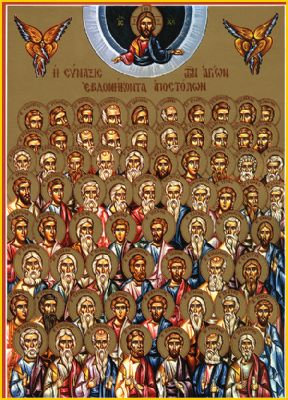From Anonimous Byzantine Chronicle #104:
The translation is based on the edition of P. Schreiner – “Short Byzantine Chronicles” (Peter Schreiner. Die byzantinischen Kleinchroniken. Teil I-III. Wien. 1977-79) – item 1 p.661-663 (Greek text) and item 3 page 135 (German translation).
Manuscripts: Athen, Benaki-Museum, 19, 417V.
Editions: Lambros, Siloge Nr. 115 (S.156-157).
Text:
1. In the year 6946 — 1437 — December 21, arrived the Patriarch of Constantinople, Joseph1, of Modon, and 29 metropolitans and bishops, and with them also other priests from the clergy of “Holy Sophia”, abbots and laymen and despot Dimitar2. They all arrived with one imperial galley and 3 of the Pope’s. They stayed 14 days in Modon.
2. In the same month, on the 28th, the emperor Cyrus John3 came from Pylos with an army. And on January 3, the patriarch left and all the members of the synod went to Pylos, where Emperor John was.
3. In 1439, November 16, arrived in Modon on the ship Gabriel Barbarigo, Emperor John and all the members of the synod. And he moved the emperor and his brother by land to Mantene.
4. And on November 23, the same year, the Latin (Frankish)4 bishop with his priests celebrated mass. And the Roman5 bishop and clergy did not arrange any mass on that very day; the Latins (Franks) and the Romans make only a hug in the Latin meat. And on the 24th of this month, in the church of Saint John the Theologian, the Roman bishop Josephus, with the secular name Kontaratos, celebrated mass, and all the clergy and the whole city, who live inside and from the surrounding area, Latins and Romans. And they also took consecrated bread – the commandant of the fortress and all the servants and their wives, in the same way as the Romans.
5. The reconciliation of the churches took place in the year 14396, during the happy Pope of Rome, Eugenius.
6. The Patriarch of Constantinople died in Florence,
7. and Metropolitan of Sardis.
8. The Latins separated from us and were excommunicated in the year 62867.
Notes:
1. Patriarch Joseph II Shishman (1416-1439).
2. Brother of the Byzantine Emperor John VIII.
3. Emperor John VIII Paleologus (1425-1448).
4. In the Greek text the Latins are called Franks.
5. Schreiner has Roman, which creates some confusion. During the Middle Ages, foreign authors (including Bulgarian) usually called the Byzantines “Greeks”. The Byzantines themselves, who were considered the successors of the Eastern Roman Empire, were called Romans. To avoid confusion in the Bulgarian language, the Byzantines are usually referred to as Romai instead of Romans.
6. It is about the concluded ecclesiastical union of the Ferrero-Florentine Council (ecumenical council of the Roman Catholic church, 1438–45).
7. We are talking about the Great Schism that occurred in 1054, during which the Eastern and Western churches split.
Photo: Icon of the 70 Apostles













 English
English French
French Spanish
Spanish German
German Dutch
Dutch Italian
Italian Danish
Danish Portuguese
Portuguese Greek
Greek Russian
Russian Swedish
Swedish Bulgarian
Bulgarian Hungarian
Hungarian Catalan
Catalan Ukrainian
Ukrainian Polish
Polish Basque
Basque Chinese (Simplified)
Chinese (Simplified) Japanese
Japanese Hebrew
Hebrew Arabic
Arabic Swahili
Swahili Amharic
Amharic Irish
Irish Afrikaans
Afrikaans Albanian
Albanian Armenian
Armenian Azerbaijani
Azerbaijani Belarusian
Belarusian Bengali
Bengali Bosnian
Bosnian Cebuano
Cebuano Chichewa
Chichewa Chinese (Traditional)
Chinese (Traditional) Corsican
Corsican Croatian
Croatian Czech
Czech Esperanto
Esperanto Estonian
Estonian Filipino
Filipino Finnish
Finnish Frisian
Frisian Galician
Galician Georgian
Georgian Gujarati
Gujarati Haitian Creole
Haitian Creole Hausa
Hausa Hawaiian
Hawaiian Hindi
Hindi Hmong
Hmong Icelandic
Icelandic Igbo
Igbo Indonesian
Indonesian Javanese
Javanese Kannada
Kannada Kazakh
Kazakh Khmer
Khmer Korean
Korean Kurdish (Kurmanji)
Kurdish (Kurmanji) Kyrgyz
Kyrgyz Lao
Lao Latin
Latin Latvian
Latvian Lithuanian
Lithuanian Luxembourgish
Luxembourgish Macedonian
Macedonian Malagasy
Malagasy Malay
Malay Malayalam
Malayalam Maltese
Maltese Maori
Maori Marathi
Marathi Mongolian
Mongolian Myanmar (Burmese)
Myanmar (Burmese) Nepali
Nepali Norwegian
Norwegian Pashto
Pashto Persian
Persian Punjabi
Punjabi Romanian
Romanian Samoan
Samoan Scottish Gaelic
Scottish Gaelic Serbian
Serbian Sesotho
Sesotho Shona
Shona Sindhi
Sindhi Sinhala
Sinhala Slovak
Slovak Slovenian
Slovenian Somali
Somali Sundanese
Sundanese Tajik
Tajik Tamil
Tamil Telugu
Telugu Thai
Thai Turkish
Turkish Urdu
Urdu Uzbek
Uzbek Vietnamese
Vietnamese Welsh
Welsh Xhosa
Xhosa Yiddish
Yiddish Yoruba
Yoruba Zulu
Zulu